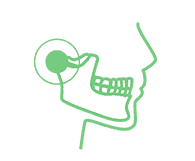
Temporomandibular joint (TMJ) syndrome is a disorder of the jaw muscles and nerves caused by injury or inflammation to the temporomandibular joint.
What is temporomandibular joint ?
It is the joint that connects your jaw to your skull. When this joint is injured or damaged, it can lead to a localized pain disorder called temporomandibular joint (TMJ) syndrome or temporomandibular disorder (TMD).
Risk factors for TMD
- Poor posture in the neck and upper back muscles may lead to neck strain and abnormalities of jaw muscle function.
- Stress may increase muscle tension and jaw clenching.
- Women 18-44 years of age have increased risk.
- Patients with other chronic inflammatory arthritis have increased risk.
- People with jaw trauma or poorly positioned teeth have increased risk.
- People who have a genetic predisposition to pain sensitivity and increased stress responses may be more susceptible.
Causes of TMJ disorders
Include injury to the teeth or jaw, misalignment of the teeth or jaw, teeth grinding or clenching, poor posture, stress, arthritis, and gum chewing.
Signs and symptoms of temporomandibular joint (TMJ) syndrome include
- Jaw pain
- Jaw clicking and popping
- Ear pain/earache popping sounds in ears
- Headaches
- Stiff or sore jaw muscles pain in the temple area
- Or locking of the jaw joint
How to relief the symptom
Home remedy
- Ice or cold packs to the area of the joint
- Over-the-counter (OTC) nonsteroidal anti-inflammatory drugs (NSAIDs), such as ibuprofen (Advil, Motrin) or naproxen (Aleve), and other pain relievers, including aspirin (Ecotrin) and acetaminophen (Tylenol)
- Eating soft foods and avoiding chewing gum
- Massage or gentle self-stretching of the jaw and neck muscles (A doctor or physical therapist can recommend appropriate stretches.)
- Relaxation techniques and stress management and reduction
- Some sedative essential oils (such as lavender, chamomile, sweet marjoram, and clary sage) may provide temporary relief from the pain and discomfort of TMJ.
When home remedies are not effective, medical treatment options may be necessary. Most of these types of treatments and remedies will not cure TMD, but they can provide temporary and even long-term relief from the pain symptoms. These include the following:
- Dental splint (occlusal splint or stabilization splint or bite guard), which is a dental appliance placed in the mouth that keeps the teeth in alignment and prevents tooth grinding. This resembles a mouth guard and is usually prescribed and fitted by a jaw specialist.
- Physical therapy with jaw exercises can strengthen muscles, improve flexibility, and range of motion.
- Biobehavioral management (biofeedback, cognitive behavioral therapy [CBT]) may help diminish pain intensity.
- Trigger point acupuncture can sometimes be helpful.
- In severe cases, surgery on the jaw or dental surgery may be necessary.
TMJ arthroscopy or arthrocentesis is a minimally invasive procedure usually done in an outpatient setting. Recovery time for this procedure is about a week.
Sometimes a total joint replacement may be necessary. This generally requires a stay in the hospital for several days, and surgery recovery time is four to six weeks.








